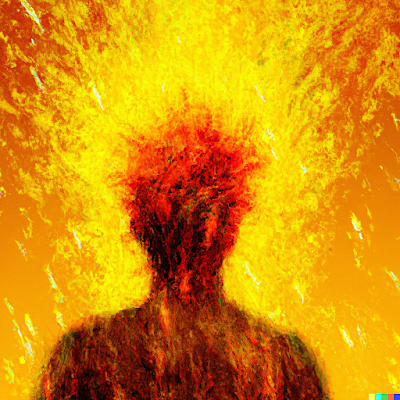Intermittent Explosive Disorder
Intermittent explosive disorder (IED) involved outbursts of impulsive aggression with no persistent mood disruption between the outbursts. It requires only 3 months for the total duration of two episodes every week on, average. There must have been At least three episodes with damage to property or injury to humans/animals within 12 months. It is diagnosed only if age is above 6 years.
 |
| A man with explosive outburst depicted in a painting |
See the ICD-11 Criteria for Intermittent explosive disorder here.
Deficits in the prefrontal cortex on
MRI have been associated with impulsivity (can aid diagnosis).1
Findings of Etiological (but not necessarily diagnostic importance):
- Reduced prefrontal grey matter >> antisocial personality disorder.2
- Reduced amygdala volume has been associated with a lack of empathy.
- Increased amygdala responses to anger stimuli > Intermittent explosive disorder
- Elevated CSF testosterone >> aggressiveness interpersonal violence (men).3
- Low levels of CSF-5HIAA >> impulsive aggression, suicide victim.
- Reduced density of 5-HT transporter sites >> suicide victims.
Treatment
Psychotherapy is difficult; however, group psychotherapy may be helpful and family therapy is useful. A goal of therapy is to have the patient recognize and verbalize the thoughts or feelings that precede the explosive outbursts instead of acting them out. Anticonvulsants have long been used, with mixed results, in treating explosive patients: Lithium works. Carbamazepine, valproate or divalproex, and phenytoin have been reported helpful. Some clinicians have also used other anticonvulsants e.g., gabapentin. Benzodiazepines are sometimes used but have been reported to produce a paradoxical reaction of dyscontrol in some cases. Antipsychotics (e.g., phenothiazines and serotonin-dopamine antagonists) and tricyclic drugs have been effective in some cases. Still, clinicians must then question whether schizophrenia or a mood disorder is the true diagnosis. With a likelihood of subcortical seizure-like activity, medications that lower the seizure threshold can aggravate the situation. Selective serotonin reuptake inhibitors, trazodone, and buspirone are useful in reducing impulsivity and aggression. Propranolol (Inderal) and other β-adrenergic receptor antagonists and calcium channel inhibitors have also been effective in some cases. Some neurosurgeons have performed operative treatments for intractable violence and aggression. No evidence indicates that such treatment is effective. A combined pharmacological and psychotherapeutic approach has the best chance of success.
Bibliography
- Sadock BJ, Sadock VA, Roiz P. Kaplan & Sadock Synopsis of Psychiatry: Behavioral Sciences/Clinical Psychiatry. 11th ed. Wolters; 2015:1499.
- Raine A, Lencz T, Bihrle S, LaCasse L, Colletti P. Reduced prefrontal gray matter volume and reduced autonomic activity in antisocial personality disorder. Arch Gen Psychiatry. Feb 2000;57(2):119-27; discussion 128-9. doi:10.1001/archpsyc.57.2.119
- Blair RJ. Neurobiological basis of psychopathy. Br J Psychiatry. Jan 2003;182:5-7. doi:10.1192/bjp.182.1.5
.png)
Comments
Post a Comment
Your Thoughts?